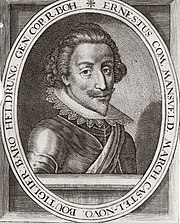
Henry Rich, 1st Earl of Holland, was an English courtier and politician executed by Parliament after being captured fighting for the Royalists during the Second English Civil War. Younger brother of Robert Rich, 2nd Earl of Warwick, a Puritan activist and commander of the Parliamentarian navy during the Wars of the Three Kingdoms, Henry was better known as an "extravagant, decorative, quarrelsome and highly successful courtier".

George Villiers, 1st Duke of Buckingham, KG(; 28 August 1592 – 23 August 1628), was an English courtier, statesman, and patron of the arts. He was a favourite and self-described "lover" of King James I of England. Buckingham remained at the height of royal favour for the first three years of the reign of James's son, King Charles I, until a disgruntled army officer assassinated him.

Denzil Holles, 1st Baron Holles, was an English statesman, best remembered as one of the Five Members whose attempted arrest by Charles I in January 1642 sparked the First English Civil War.

Sir William Waller JP was an English soldier and politician, who commanded Parliamentarian armies during the First English Civil War. Elected MP for Andover to the Long Parliament in 1640, Waller relinquished his military positions under the Self-denying Ordinance in 1645. Although deeply religious and a devout Puritan, he belonged to the moderate Presbyterian faction, who opposed the involvement of the New Model Army in politics post 1646. As a result, he was one of the Eleven Members excluded by the army in July 1647, then again by Pride's Purge in December 1648 for refusing to support the Trial of Charles I, and his subsequent execution in January 1649.

Marmaduke Langdale, 1st Baron Langdale was an English landowner and soldier who fought with the Royalists during the Wars of the Three Kingdoms.
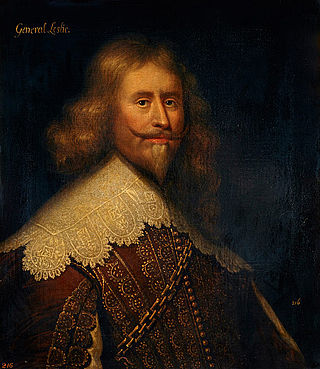
Alexander Leslie, 1st Earl of Leven was a Scottish military officer and peer. Born illegitimate and raised as a foster child, he subsequently advanced to the rank of field marshal in Swedish Army, and in Scotland became Lord General in command of the Army of the Covenanters, a privy councillor, captain of Edinburgh Castle, Lord Balgonie and Earl of Leven. In England he commanded the Army of the Solemn League and Covenant and was senior commander of the Army of Both Kingdoms (1642–1647). Leslie served in the Thirty Years' War, the Bishops' Wars, and most of the English Civil War, fighting primarily in the First English Civil War. Leslie would live a long life, dying roughly at the age of 80 or 81.
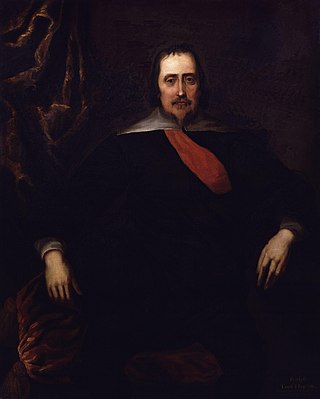
Ralph Hopton, 1st Baron Hopton was an English politician, military officer and peer. During the First English Civil War, he served as Royalist commander in the West Country, and was made Baron Hopton of Stratton in 1643.
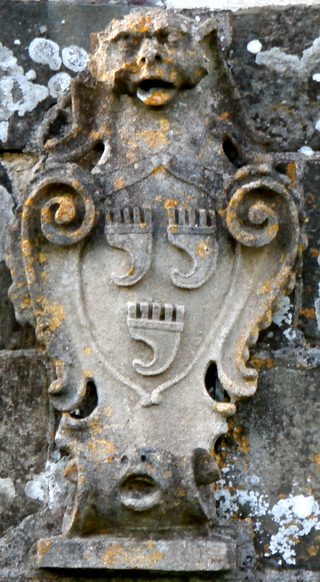
Sir Richard Grenville was a professional soldier from Cornwall, who served in the Thirty Years War, and 1638 to 1651 Wars of the Three Kingdoms. He was the younger brother of Sir Bevil Grenville, who died at Lansdowne in 1643, and grandson of Admiral Sir Richard, killed at Flores in 1591.

Sir Hardress Waller, was an English Protestant who settled in Ireland and fought for Parliament in the Wars of the Three Kingdoms. A leading member of the radical element within the New Model Army, he signed the death warrant for the Execution of Charles I in 1649; after the Stuart Restoration in 1660, he was condemned to death as a regicide, a sentence commuted to life imprisonment.

The Second English Civil War took place between February and August 1648 in England and Wales. It forms part of the series of conflicts known collectively as the 1639–1653 Wars of the Three Kingdoms, which include the 1641–1653 Irish Confederate Wars, the 1639–1640 Bishops' Wars, and the 1649–1653 Cromwellian conquest of Ireland.

The First English Civil War took place in England and Wales from 1642 to 1646. It is part of the 1639 to 1653 Wars of the Three Kingdoms, which also include the Bishops' Wars, the Irish Confederate Wars, the Second English Civil War, the Anglo-Scottish war (1650–1652) and the Cromwellian conquest of Ireland. Historians calculate some 15% to 20% of all adult males in England and Wales served in the military between 1639 and 1653, while around 4% of the total population died from war-related cause, versus 2.23% in World War I. These figures illustrate the impact of the conflict on society in general, and the bitterness it engendered.

The Engagers were a faction of the Scottish Covenanters, who made "The Engagement" with King Charles I in December 1647 while he was imprisoned in Carisbrooke Castle by the English Parliamentarians after his defeat in the First Civil War.
Sir Arthur Aston was a soldier, most noted for his support for King Charles I in the English Civil War, and in folklore for the gruesome manner of his death in Ireland. He was from a prominent Roman Catholic family originating in Cheshire. He was killed during the Siege of Drogheda during the Cromwellian Conquest of Ireland.

The Treaty or Peace of Lübeck ended the Danish intervention in the Thirty Years' War. It was signed in Lübeck on 22 May 1629 by Albrecht von Wallenstein and Christian IV of Denmark, and on 7 June by Ferdinand II, Holy Roman Emperor. The Catholic League was formally included as a party. It restored to Denmark–Norway its pre-war territory at the cost of final disengagement from imperial affairs.

Sir George Lisle was a professional soldier from London who briefly served in the later stages of the Eighty and Thirty Years War, then fought for the Royalists during the Wars of the Three Kingdoms. Captured at Colchester in August 1648, he was condemned to death by a Parliamentarian court martial and executed by firing squad along with his colleague Charles Lucas.
Memoirs of a Cavalier (1720) is a work of historical fiction by Daniel Defoe, set during the Thirty Years' War and the English Civil Wars. The full title, which bore no date, was:
Memoirs of a Cavalier; or A Military Journal of the Wars in Germany, and the Wars in England. From the Years 1632 to 1648. Written threescore years ago, by an English gentleman, who served first in the army of Gustavus Adolphus, the Glorious King of Sweden, till his death, and after that in the Royal Army of King Charles the First, from the beginning of the Rebellion to the end of the War.

William Ogle, 1st Viscount Ogle was an English soldier from Northumberland who settled in Hampshire and was Member of Parliament for Winchester from 1640 to 1643. He served in a number of wars and was Royalist governor of Winchester from 1643 to 1645.
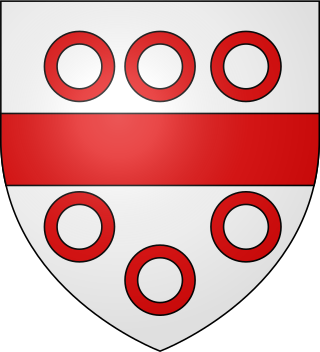
Sir Thomas Lucas, was a professional soldier from Lexden, just outside Colchester in Essex, England, who served with the Dutch States Army in the Eighty Years War and later fought in the Irish Confederate Wars.
The Eleven Members were members of the House of Commons of England, who were identified by commanders of the New Model Army as their principal opponents. They were suspended and forced into exile for six months; after the 1648 Second English Civil War, many were permanently removed in December 1648.

The Battle of St Neots on 10 July 1648 was a skirmish during the Second English Civil War at St Neots in Cambridgeshire. A Royalist force led by the Earl of Holland and Colonel John Dalbier was defeated by 100 veteran troops from the New Model Army, commanded by Colonel Adrian Scrope.

